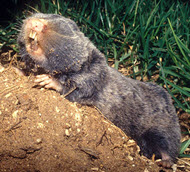Words translated as
“mole” in English Bibles
The Germanic-English word “mole” is presumed by some to be equivalent to two ancient Hebrew creature names in Scripture.
-
choled or choledh
Hebrew: חֹ֫לֶד —transliteration: choled or choledh
This ancient Hebrew noun occurs only once in the entire Bible, in Leviticus 11:29. It is listed among the unclean animals that the Chosen People were not to eat. It is no longer clear what this creature is or whether it is extinct. Some very ancient Hebrew words for animals are no longer clearly understood, such as behemoth and leviathan (both probably extinct creatures), and have thus been translated poorly by some.
“Now these are to you the unclean among the swarming things which swarm on the earth: the mole, and the mouse, and the great lizard [or thorn-tailed lizard] in its kinds…” —Leviticus 11:29 NASB
The King James Bible translators and some others called it a “weasel” (KJV, NRSV, NIV). Many other translators called it a “mole” (NASB, Darby, ERV, ESV), others a rat (CEB, ISV, NET), and others a mole-rat (ESV, ESVUK, NLT).
It seems to be some burrowing animal, but it is not clear which translation is correct, if any.
If a mole or rat type animal, then the Middle East Blind Mole Rat seems a likely candidate. The true mole (an Insectivora) of Europe and North America is not found in Israel, but a creature that does, in abundance, is the mole-rat. It “lives in underground communities, making large subterranean chambers for its young and for storehouses, with many runs connected with them, and is decidedly partial to the loose debris among ruins and stone-heaps, where it can form its chambers with least trouble.”

These mole-rats (Genus Spalax—a rodent) are “twice the size of our mole, with no external eyes, and with only faint traces within of the rudimentary organ; no apparent ears, but, like the mole, with great internal organs of hearing; a strong, bare snout, and with large gnawing teeth; its color a pale slate; its feet short, and provided with strong nails; its tail only rudimentary.”
The King James translators used the word mole one other time.
In that day a man shall cast his idols of silver, and his idols of gold, which they made each one for himself to worship, to the moles and to the bats… —Isaiah 2:20 KJV
Here, the word “moles” is the translation of two different Hebrew words פֵּר֖וֹת (transliterations: haphar, chephor, chaphar) and לַחְפֹּ֥ר (peroth), which are rendered by Friedrich Wilhelm Gesenius (1846) “into the digging of rats,” i.e., rats’ holes. פֵּר֖וֹת means “to dig”.
These two Hebrew words perhaps ought to be combined into one (hapharperoth/haphárperôth/chephorperoth), i.e., the rat-moles or mole-rats or digging rats, or some other burrowing animal (continual diggers).
Smith’s Bible Dictionary states that “the word [chephor peroth] means burrowers, hole-diggers, and may designate any of the small animals, as rats and weasels, which burrow.”
-
tinshemeth or tinshameth
Hebrew: תִּנְשָׁ֫מֶת —transliterations: tinshemeth or tinshameth
The word “mole” appears again in the King James Version (see Leviticus 11:30). This is translated from a different ancient Hebrew word.
This word occurs only 3 times in Scripture: Leviticus 11:18; 11:30; Deuteronomy 14:16.
Again, the creature being named by this ancient word is lost to time. In any case, it was declared unclean and struck off the list of creatures allowed in the diet of God’s Chosen People, the Israelites.
Diverse candidates have been suggested:
- chameleon (ASV, NASB, ESV, RKJV)
- owl
- white owl (NASB, NKJV, AMP, CEB, EXB, HCSB, ICB, MEV, NCV, NET, NIRV, NIV, NLV, etc.)
- barn owl (ESV, CSB, GW, LEB, NOG, NLT)
- horned owl (ASV, CJB, NABRE)
- swan (KJV, AKJV, Darby, AMPC, BRG, DRA, GNV, JUB, WYC, YLT)
- water hen (RSV, NRSV, NRSVCE, RSVCE, CEB)
Note that the King James Bible translates תִּנְשָׁ֫מֶת as two quite different animals—“swan” (Leviticus 11:18 and Deuteronomy 14:16) and “mole” (Leviticus 11:30). Other translations also use more than a single animal for this same Hebrew noun.
More information
- About the ancient Hebrew language
- Animals of the Bible
- What is “clean” and “unclean” in the Bible?
- chameleon
- owl
- swan
- lizard
- versions of the Bible